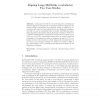Free Online Productivity Tools
i2Speak
i2Symbol
i2OCR
iTex2Img
iWeb2Print
iWeb2Shot
i2Type
iPdf2Split
iPdf2Merge
i2Bopomofo
i2Arabic
i2Style
i2Image
i2PDF
iLatex2Rtf
Sci2ools
ESWS
2010
Springer
2010
Springer
Aligning Large SKOS-Like Vocabularies: Two Case Studies
In this paper we build on our methodology for combining and selecting alignment techniques for vocabularies, with two alignment case studies of large vocabularies in two languages. Firstly, we analyze the vocabularies and based on that analysis choose our alignment techniques. Secondly, we test our hypothesis based on earlier work that first generating alignments using simple lexical alignment techniques, followed by a separate disambiguation of alignments performs best in terms of precision and recall. The experimental results show, for example, that this combination of techniques provides an estimated precision of 0.7 for a sample of the 12,725 concepts for which alignments were generated (of the total 27,992 concepts). Thirdly, we explain our results in light of the characteristics of the vocabularies and discuss their impact on the alignments techniques. Key words: vocabulary alignment. case study, cultural heritage, methodology
| Added | 19 Jul 2010 |
| Updated | 19 Jul 2010 |
| Type | Conference |
| Year | 2010 |
| Where | ESWS |
| Authors | Anna Tordai, Jacco van Ossenbruggen, Guus Schreiber, Bob J. Wielinga |
Comments (0)

